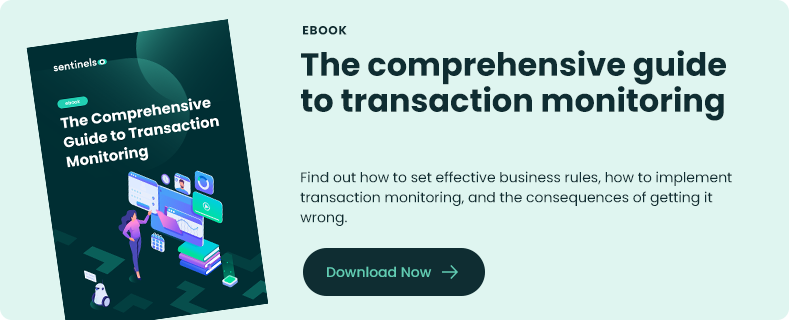Evolving criminal typologies, a growing attack surface, and regulatory developments are moving transaction monitoring compliance goalposts in the financial industry today.
In order to detect and prevent financial crimes such as money laundering and meet key compliance requirements, regulated firms operating in this sector must work to build a comprehensive understanding of the financial activities of their customers.
One of the most effective methods that firms can use to do this is through a robust transaction monitoring regime.
What is transaction monitoring?
Transaction monitoring helps regulated firms in the banking and finance sector to detect and prevent money laundering and other types of financial crime.
Information that is collected during transaction monitoring helps firms to meet obligations under critical anti-money laundering regulations, Know Your Customer requirements, and suspicious activity reports (SARs).
Transaction monitoring is a mandatory process for regulated financial institutions in most jurisdictions, and it has been for many years. But not all transaction monitoring processes have been created equally. Firms that are using old-school processes that are human-led and require lots of manual intervention, for example, will find that their transaction monitoring is costly, resource-intensive, and prone to triggering false positives.
It doesn’t need to be this way, though. Modern transaction monitoring software and tools have been created to help firms eliminate many of these pain points.
What is transaction monitoring software?
Transaction monitoring software helps regulated firms to automatically spot suspicious transactions, such as unusual account activity or large cash deposits, and reduces the need for human oversight and intervention.
With the support of technology and artificial intelligence (AI), modern software can spot things that humans simply cannot and detect suspicious activity much more quickly than even the most effective compliance teams.
This is made possible through data. Transaction monitoring software analyzes every single data point that’s connected to a particular transaction and compares them to defined risk rules. The system then automatically flags suspicious activity, such as:
- Unusual transactions.
- Transactions that exceed a defined value.
- Large cash deposits or withdrawals.
- Funds with unknown sources.
- Transfers to or from flagged accounts.
If the flagged transaction breaks certain risk rules (i.e., it’s completely unusual and there’s no explanation for it) the data that’s attached to it will typically be compiled in a SAR and submitted to the relevant local authority who can then carry out their own investigation.
With the growing and sophisticated threats that are posed by today’s financial criminals, the deployment of robust transaction monitoring software is the only way for firms to stay ahead and within the boundaries of compliance.
Why does transaction monitoring software matter?
Regulated firms must comply with certain regulations. In the European Union, for example, they must comply with the Anti-Money Laundering Directive (AMLD), the latest being 6AMLD.
The key to being compliant with these and other regulations is through the monitoring, flagging, and reporting of suspicious transactions with the help of transaction monitoring software.
This software can help regulated firms monitor customer transactions in real-time, as well as evaluate previous and current customer interactions, to provide a comprehensive, transparent overview of their activities. This allows firms to identify suspicious activities or high-risk transactions and investigate them quickly.
The right transaction monitoring software can help you to:
- Avoid being penalized with hefty fines.
- Give confidence to commercial partners.
- Reduce operational costs associated with human-led transaction monitoring.
- Adopt a risk-based approach to customer account management.
- Protect your reputation.
Transaction monitoring software also helps to support a firm’s compliance function by equipping them with the tools they need to quickly analyze customer data in a streamlined and automated way and act decisively on what they find. Additionally, compliance teams benefit from the confidence that the information that they’re acting on is accurate and that they’re taking the right action at the right time.
Transaction monitoring and emerging risks
Traditional, human-led transaction monitoring was a suitable solution back when the world was a simpler place. However, the last couple of decades—and indeed, the last couple of years—have shown us beyond doubt that the modern world is anything but simple.
We have recently seen an unprecedented number of economic sanctions imposed upon Russia in response to its invasion of Ukraine, for example. This has led to an explosion of new risks, such as the misuse of cryptocurrencies and decentralized exchanges as people and businesses from within Russia attempt to circumvent these sanctions.
A recent case in the UK of Gidiplus, a firm offering crypto ATM services, is a good example. This firm was ordered to cease its activities following an investigation that found Gidiplus was unable to undertake “meaningful transactions monitoring in relation to a proportion of its transactions” because it did not attempt to assess the nature of its business relationships with customers at the point of onboarding. The FCA branded Gidiplus as operating illegal crypto ATMs.
The owner of Gidiplus also prevented banks from meeting their own KYC obligations by misrepresenting that his company carried on an events business. “He compounded the situation by seeking to disguise the nature of the transactions that went through the Gidiplus’s accounts,” said the UK’s Tax Tribunal.
Transaction monitoring can help firms safeguard against threats such as those posed by firms like Gidiplus through automated in-depth analysis. Transactions are looked at holistically by the system, leading to improved detection rates and accuracy.
Find out how to implement transaction monitoring effectively at your business with our comprehensive guide to transaction monitoring


